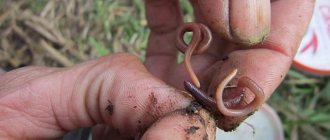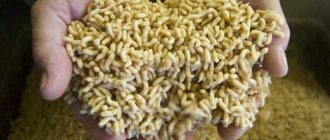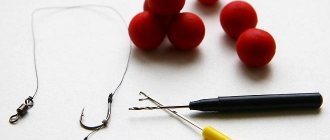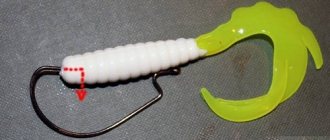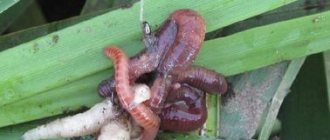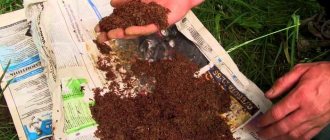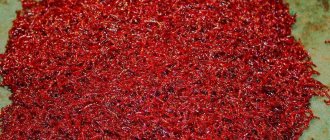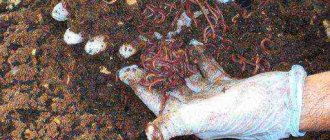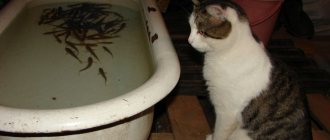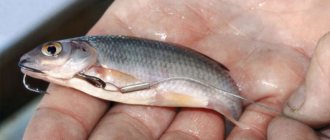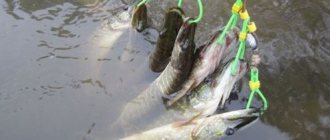What is a bloodworm?
This bait is the larva of a long-lasting mosquito, which lives in abundance in water bodies. Externally, the larva is very similar to a small red worm . The bloodworm lives in shallow water in grassy thickets. You have to get a little wet to catch it, but the results are worth it.
To extract bloodworms, you need to scoop up the sludge with a bucket and wash it on a fine sieve or gauze. There is an even easier method that can be used almost all year round. It is necessary to put a piece of meat or fish in a cloth and bury it in the mud. This bookmark should be left overnight. Next, you just need to take it out and select the larvae gathered here.
In order for the bait to survive until fishing, you should immediately place it in a storage container . Such a place could be a styrofoam box with damp moss or even a potato cut in half with the core cleaned out.
Bloodworms come in several types and differ in size. Moreover, these are the larvae of completely different insects, which simply reproduce in the same way. Large individuals are considered preferable for fishing. However, this opinion is not entirely correct - yes, for large fish they are more noticeable, but not more desirable, due to the fact that small bloodworms wriggle more attractively and thereby attract attention.
There is also a feed bloodworm, which is most often used as an additive to bait.
Which hooks are best?
The main rule of the float angler is: the hook is selected not according to the size of the intended fish, but to the size of the bait.
Read Tents for winter fishing
To catch mosquito larvae, hooks with the following characteristics are used:
- Size – for fishing with small hooks No. 12-14 according to the European classification are used;
- Forend length – for fishing, hooks are taken that have a long forend ending in a ring;
- Color - in order to most effectively camouflage the hook on which this bait is mounted, take special models whose surface is painted bright red or ruby;
- Thickness – so that the contents of the bait do not leak out, and the bait itself is minimally damaged. Preference is given to models made of thin and durable wire.
When selecting hooks for bloodworms, they are guided by the shape, sharpness of the sting, size and thickness of the wire. A dull or dull tip will always cause damage to the bait. At the same time, the beautiful ruby worm turns into a shapeless spittle, which becomes unattractive to fish.
Important points when fishing for bloodworms
Today there are several main methods of catching this red worm. In order to catch large fish, you should attach several bloodworms on one hook at once, and to catch fry, you can use one larva. You need to put it on very carefully so as not to damage it. Hands must be dry , since the bloodworm itself is wet and sticks to the fingers.
hook is considered ideal . This option is convenient for the larvae and will allow you to lure fish. It is especially important to correctly position not only the hook with bait, but also the float - when fishing with bloodworms, you need to make sure that only the antenna of the float is visible from the water. This will allow you to react more sensitively to bites.
Bloodworms are a rather delicate bait and therefore must be handled correctly. The correct choice of bait in the store is also important. Preference should be given only to active larvae that are bright and moving.
Options for attaching bloodworms to a hook
The effectiveness of the entire fishing trip often depends on the method of baiting. Today, professional fishermen use several main options:
How to catch more fish?
I have been active fishing for quite some time and have found many ways to improve the bite. And here are the most effective:
- Bite activator. Attracts fish in cold and warm water with the help of pheromones included in the composition and stimulates its appetite. It’s a pity that Rosprirodnadzor wants to impose a ban on its sale.
- More sensitive gear. Reviews and instructions for other types of gear can be found on the pages of my website.
- Lures using pheromones.
You can get the rest of the secrets of successful fishing for free by reading our other articles on the site.
- The most common of them is the head attachment . The bloodworm should be pierced in the area of the head, while it remains in a free position.
- For a more active bite, the sandwich , in which the larvae alternate with other bait: maggots, corn grains.
- With the standard and more traditional method of attachment, the body of the bloodworm must be pierced through the middle . Thus, you can put from one to several larvae on the hook.
- When the fish has completely stopped biting, you should use a new method in which the bloodworm clings to the head and tail. The main thing here is to give the bait a ring shape and cover the sting.
- The most difficult and at the same time popular is considered to be “stocking” . The mosquito larva is put on a hook over the head and the whole body like a stocking.
- A method is also often used in which the sting is inserted and withdrawn in the middle of the body so that a small piece is skewered.
- Fishermen who are keen on sport fishing value their bait method. In this case, the hook is inserted in the middle of the body, but the sting is removed from the side of the head. It turns out that the bloodworm is half dressed like a stocking, and the other half hangs freely.
Features of placing bloodworms on a hook
In order not to return without a catch, you need to know some of the features of placing bait on a hook. For bloodworms, you should choose a hook made of fairly thin wire . Experts recommend using only fresh bait: such larvae are mobile and have a bright color.
After any bite, you should replace the bait with a fresh one . In this case, whether the bite was successful or not does not matter. It is especially important to place the bloodworm correctly on the hook: it should not hang down or leak out. You need to hold it with one hand and not squeeze too hard. In winter, for convenience, you can freeze the larvae a little and only then attach them to the hook.
Since the bloodworm is quite small in size, it is worth using small hooks as gear. However, there are certain difficulties: how to put on the bait and not damage it.
It is convenient to do everything with dry hands. Most often, the beam method , when several larvae are put on a hook at once.
Moreover, the sting passes through the middle of the larva’s body. Unfortunately, other methods of baiting will not work here, since the hook will not be able to hold the bait and most likely the fish will simply pull it off.
Recommendations
Before you begin testing the presented methods, you need to consider some important aspects:
- For all methods, with the exception of bunching, a special hook for bloodworms is used. It is made of thin wire, the diameter of which allows installation without serious damage to the body.
- It is better to use selected bloodworms that are bright red in color and actively move. The bite on such bait will be much better.
- The bait is replaced after each bite or every 10-15 minutes. This will keep the fish interested and get a good result from the effort spent.
- single;
- beam
When purchasing bait, you need to pay attention to its color - it should not be brown, this indicates the unsatisfactory condition of the product. Most likely, the bloodworm will not live to see fishing or will stop showing signs of activity in the first hour of fishing.
"Stocking". Outwardly, it is a very simple method in which a worm is usually attached. And most importantly, with such a bait, the fish has practically no chance of leaving after biting. But it’s not easy to pierce a bloodworm from head to tail without some skill.
Bloodworms are the most popular bait, after worms and maggots, for amateur and sport fishing, especially in winter from the ice. But if, as a rule, even novice fishermen do not have any problems with attaching a worm, then with bloodworms the matter is more complicated. It is very thin and breaks and leaks easily.
There are 2 types of mounting:
8 mounting methods
"Ring". This method of baiting is used when the fish bite is sluggish and rare, when each bite has a special price. The bloodworm is pierced in the head part, and then launched into the tip of the tail, so that the bloodworm forms a ring with a “moving” head. The fish is practically unable to rip off such a bait.
"Stocking". Outwardly, it is a very simple method in which a worm is usually attached. And most importantly, with such a bait, the fish has practically no chance of leaving after biting. But it’s not easy to pierce a bloodworm from head to tail without some skill.
Sports way . During very active biting or in competitions, when minutes count, the bloodworm is pierced along the body of the larvae with a hook approximately in the middle, and then the hook is brought out towards the head or tail. Sometimes they do it even simpler: they string several larvae with the sting of a hook according to the principle “just to hold on.”
Placing bloodworms in a bunch. Variations of this method are used when catching large fish and using fairly large hooks. Previously (and often now) bloodworms were tied into a bundle of 8-10 larvae with a simple thread, which was then pinned onto a hook or jig. But working with thread, especially in the cold, is not very convenient. Therefore, other devices began to be used for knitting.
Tying a bunch of bloodworms with nipple rubber. A cut is made on the plastic rod of a gel fountain pen with a diameter of 0.5-0.8 cm, which turns one of its ends into a small scoop. On the other side, cut rings made of nipple rubber are put on the rod. We scoop out the bloodworm with a scoop, and then lower the elastic band onto the resulting bunch. Such ready-made bundles are then simply hooked onto the shank of the hook.
Tying a bunch of bloodworms with a bunch knitting machine . The bundle tie is a special device that is produced industrially and sold in fishing stores. A device with special legs that stretch the elastic band collects a handful of bloodworms, and then the elastic band moves and clamps the bundle with the hook.
Placing a bunch of bloodworms on clothespin hooks . Such hooks, sold in fishing stores, have a double profile (parallel shank), but one sting. A special loop opens this profile and, after collecting a bunch of bloodworms, compresses it again.
[THERE IS AN ANSWER] How to catch bream with a float rod
Knots for tying a leash to a fishing line - used in both feeder, float and spinning fishing.
How to choose the right fishing line for fishing - a guide to comparing monofilament, braid and fluorocarbon.Hook knots - rating of the strongest.
Knowledge of the rules and methods of attaching such popular baits as bloodworms and maggots will help fishermen, especially beginners, quickly improve their skills and... catches.
When the bite is sluggish (and this means often), it is desirable that the maggot remains alive, and even retains its agility. This provokes fish better than a motionless dead larva. But the maggot can retain its vitality provided that its insides are not damaged by the hook. Therefore, the classic recommendation for baiting a maggot looks like this: - use the tip of a hook to pry the skin near the head between the so-called “eyes”, then bring the sting out under the skin and move the maggot towards the forearm.
Even experienced fishermen do not know exactly how best to place a bloodworm or maggot on a hook, so that on the next cast the fish will finally stop resting and start catching.
The question “how to best place bait on a hook” is one of thousands among experienced fishermen, in the context of their constant search for secret techniques for successful fishing. And for beginner fishing enthusiasts, this question is direct and essential - really, how to properly attach a bloodworm or maggot to a hook?
Place the bloodworm on the hook
The usual recommendations for planting bloodworms are as follows.
- Only extremely thin “crank” hooks are used. You shouldn’t even try to pull a moth onto a “carpokiller” hook.
- Bloodworms are selected before baiting. The largest larvae with the most pronounced fighting qualities are used. It bites much better on a moving larva.
- We replace the bloodworm on the hook with a fresh one in time. Then you can get the most from the reservoir.
Hanging
One bloodworm is taken with the fingers of one hand (be careful not to crush it). The hook is taken with the other hand. The bloodworm is then pierced with a sting approximately between 3 and 4 segments from its head. The hook is removed from the larva near the head itself, and it moves to the bend of the hook. That's all - the living creatures do not lose their vitality for a long time (about 15 minutes) and remain attractive to fish.
According to some anglers, the attractiveness of the bait will increase if a pair or three larvae are attached to the hook in a similar way. This is especially true when it comes to catching heavy fish.
A bloodworm hanging from a hook is good when the fish is moderately active and will greedily grab it, swallowing it along with the hook. But this rarely happens. Much more often, the fish carefully takes the mosquito larva by the tail and pulls it off the hook, leaving the angler with only empty hooks over and over again.
Stocking
With the weak, the method of baiting bloodworms with a “stocking” helps. It's easy to do. In the same way, the larva is pierced near the head, only this time the sting is directed towards its tail. With careful movements of the fingers, it is pulled onto the hook. Tail droop is minimized as much as possible, but the hook is not removed from the body. Now the fish has nothing special to pull off the larva, and it captures it immediately along with the hook.
Accidentally hitting
Everything is not bad, but such actions require a lot of time and sleight of hand. But what to do in a situation when the fish is really hungry and every second counts? Or when in the cold your fingers are hard to control? Or in a situation where your hands are shaking and you can’t even see one bloodworm? Then the method of attaching a bloodworm to the rescue comes to the rescue.
The bloodworm ball is grabbed with two fingers. Then, the hook is pierced several times through the entire ball, and within a second, one or several bloodworms or parts of them are somehow picked up on it. And such a bait is sent into the water (under the ice), and with a passionate bite, the fish are caught no worse than if the fisherman very diligently put on the bloodworm for several minutes and examined the results of his work.
Big bunch - big catch
To catch large fish, anglers sometimes use a whole bunch of bloodworms tied to a hook. For example, this is often done when fishing for bream. A small piece of nipple elastic will help secure the bunch of bloodworms to the hook. When fishing, the entire bunch is planted in seconds - just insert the sting into the nipple, which already contains several bloodworms. And the thickness of the hook now does not play any role, which is a big plus for catching large fish.
But how to thread a bloodworm into a nipple, and even a whole bunch?
How to thread a bloodworm through an elastic band
The simplest device that every angler can make with his own hands will help. Take a plastic handle and throw out all the guts. The body is cut with a knife “on an oblique”, so that at its cut end something in the form of a scoop with a pointed nose is formed. Then a short piece of elastic is pulled onto this body through its sharp part. Several bloodworms are placed on the scoop, and the nipple is pulled off the handle, simultaneously capturing all the bloodworms located “in the scoop.”
Having spent half an hour at home preparing the bunches and n-number of elastic bands, the fisherman will come to the pond, as they say, fully armed. By the way, the nipple, after the bloodworm is eaten by the fish, can be used for the second pass.
If bloodworms can be planted in any way you like - “as it turns out” or as your imagination dictates, and at the same time, not without reason to count on a bite, then with maggots the situation is somewhat more complicated. One circumstance adds special features to its use - this larva has a very hard and durable skin.
Live maggot
When the bite is sluggish (and this means often), it is desirable that the maggot remains alive, and even retains its agility. This provokes fish better than a motionless dead larva. But the maggot can retain its vitality provided that its insides are not damaged by the hook. Therefore, the classic recommendation for baiting a maggot looks like this: - use the tip of a hook to pry the skin near the head between the so-called “eyes”, then bring the sting out under the skin and move the maggot towards the forearm.
This way you can plant several maggots to catch large fish. After biting (catching a fish), it often happens that the maggot on the hook remains intact, alive and fidgety, and is suitable for re-casting.
Baiting options
A maggot can very easily take revenge on a fisherman for being hooked to be eaten by fish. It wraps itself around the hook and simply covers the sting with its body. Further: - the fish bites, the float quickly moves away to the side with a dive, the fisherman even waits to spot the carp (whale) for sure, aaaand... and on the hook there is only a smiling maggot.
If the larva covers the sting with its hard skin, then it will not be possible to hook the fish. Therefore, when the bite is confident, fishermen bait the maggot with a stocking, after which it quickly dies. Or, many fishermen recommend doing a combination of baiting techniques - a couple of larvae are put under the skin to keep them alive, and then a maggot pierced through its length is placed near the sting.
Whenever baited, the hook tip is always removed from the body of the blowfly larva, and remains free for hooking fish.
[THERE IS AN ANSWER] How to catch bream on a feeder
How to make larvae immobile
Sometimes, for conditions of confident biting on bait, or when there is not enough time at competitions, anglers specially use killed larvae so that they do not interfere with the bait with their fidgetiness and do not make idle hooks. Maggots are killed with heat. In order not to cook it over a fire, the larvae are first cooled (spring water), then immediately placed in hot water (tea from a thermos). After this procedure, the fisherman confidently throws maggots on a hook towards the ever-hungry mouth of the long-awaited carp.
In this video, Alexander Serykh, representative of the Novosibirsk region team at the Russian Ice Fishing Championship, will show these bait methods and tell you when he uses them.
Have you often encountered the fact that there is a fish on the hole, even reacting to the bait, but you just can’t catch it? Bite after bite, and all the hooks are empty. Has it happened?
Often, this happens due to the size of the jig itself or the size of the hook. If the jig is too large for the fish that reacts to it with empty bites, it makes sense to reduce its size. A smaller jig, made of the same material and on a fishing line of the same diameter, will give the bait a smooth fall and allow the fish to suck itself in with less effort. The number of successful bites will increase.
Did you know that the main reason for empty bites when fishing with bloodworms is the wrong attachment on the hook? Incorrectly placed bloodworms often lead to the fact that when there are many fish bites, we only get one or two out of the hole.
“The correct method of attaching a bloodworm to a hook is one in which the number of empty bites is minimal”
Below, we will show 5 types of attachments for one bloodworm. Note that all 5 methods will be both correct and incorrect at the same time, since the appropriate method is always selected for the fish you are catching. That is, at the fishing site.
But first, let's look at the bloodworm and denote the following:
- The bloodworm has a head and a tail
- The head part is dark, the tail part has a forked tail.
- The bloodworm is divided into segments (“sections”)
The structure of this larva is more complex, but that’s all you need to know in order to place it on a hook without any problems.
Attaching a bloodworm to the head
This method is searchable and popular. It takes a minimum of time to attach a bloodworm to the head, so sports fishermen often start searching for fish with this method.
By placing a bloodworm behind the head, we get the most active game, since most of it remains in a mobile state. Along with the game of the jig, the bloodworm also plays. As a rule, this fact has a positive effect if there are active fish in the fishing area.
But we also consider the long overhang of the bloodworm to be a disadvantage of this type of bait. If the fish is inactive and is not in the mood to greedily grab the bait, it will more often “pinch” the tip of the bloodworm, and empty hooks will begin.
To place the bloodworm behind the head, we retreat two or three “sections” of the head part of the bloodworm and pierce it. It's simple!
Bloodworm attachment with a ring
This method appeared as a simple solution to the problem of empty bites when baited behind the head. We took the bait out of the water, put the tail on the sting and continued fishing. Often this is enough to get rid of empty hooks.
When attaching a bloodworm with a ring, the resistance of the bait increases, due to which the fall becomes a little longer. You may hardly notice it, but the fish will most likely take notice. When catching passive fish on a drop, this bait method often bears fruit.
To put a ring on the bloodworm, we retreat two or three “sections” of the head part and place it on the hook. Now we retreat two or three “sections” of the tail section and pierce them.
Attaching a bloodworm with a stocking
It happens that a cautious roach is alarmed by the hook, which is visible when using the methods described in the first two cases. The fish both wants to eat our bait and is afraid. This method of attaching bloodworms solves this problem.
Attaching a bloodworm with a stocking reduces the volume of the bait, which can also have a positive effect in the presence of empty bites. The fall becomes a little faster.
To attach a bloodworm with a stocking, enter the sting into the center of the head of the bloodworm and bring it to the middle (closer or further, depending on the size of the larva and the size of the forearm), without moving the sting out.
Attaching the bloodworm with a stocking “in reverse”
This is an extremely rare case, and not everyone will be able to identify it, but the fish can be so wary that they can feel the sting of the hook while tasting the bait. In this case, frightened, she leaves the bait.
This is how the method of attaching bloodworms with a stocking “in reverse” appeared. In this case, the remaining dangle of the bloodworm is not at the sting, but on the reverse side. Thus, a cautious fish sucks on a bloodworm and, without being pricked, sucks in the bait entirely.
Note that for both methods of baiting with a stocking, only jigs with a sharp sting and a thin hook wire are suitable.
To attach a bloodworm with a stocking “in reverse”, enter the sting into the middle part of the bloodworm and bring it to the head part, without moving the sting out. Ready!
Bloodworm attachment with a puncture in the middle
This method is the second most popular after the head attachment. It is also simple and requires minimal time and effort.
When attaching a bloodworm with a puncture in the middle, we get two playing parts of the bloodworm. It is important that both overhangs are not as long as in the first case described in the article. Thus, the bloodworm plays at a high frequency.
To plant a bloodworm this way, visually divide the larva in half and pierce it in the middle.
5 ways to attach bloodworms VIDEO
In this video, Alexander Serykh, representative of the Novosibirsk region team at the Russian Ice Fishing Championship, will show these bait methods and tell you when he uses them.
No matter how simple this information is for you, do you remember it while fishing? After all, it is these simple truths that can often significantly increase your catch.
Find the right approach to the fish. Use a variety of bait presentations and experiment with bloodworm baits. There will definitely be a result.
- pressed to the shank of the hook
The bloodworm is a worm up to 13 mm long, mostly red, but sometimes greenish. It is the larva of the long-lasting mosquito and lives in the bottom silt of ponds, lakes, and river creeks. The bloodworm lives in the water for some time, and then it pupates and turns into a mosquito. Bloodworms are an excellent bait; they are used both in winter and summer, but more often in winter. A large bloodworm is placed on a hook, and a small one is used to bait fish.
You can attach bloodworms to a hook in the following ways:
1) The bloodworm can be put on the hook with a “stocking”, the sting is inserted through the “tail”. The bloodworm dies immediately.
What is the advantage of this method? - you can hide the sting of the hook.
Minus - unfortunately, one bloodworm cannot attract larger fish, and for baiting with a “stocking” only a large bloodworm is required, the middle one is no longer suitable.
2) In my opinion, the best way to attach bloodworms is with a “brush”. In this case, the sting of the hook is used to pierce the bloodworm’s body just below its black head. The bloodworm also dies almost immediately, but still remains more attractive to fish than if baited with a “stocking”. You can plant one bloodworm or several. For example, 5-8 larvae are planted for bream, 2-3 for perch, and 1 bloodworm for roach in the middle of nowhere.
Pros - it is possible to plant several larvae, which attracts large fish. The bloodworm can also bend and look natural.
Disadvantages - the free tail of the bloodworm likes to suck small things, in the end it may turn out that the small fish simply sucks out the bloodworm and only the less attractive translucent skin remains.
3) This method of mounting may be useful. The bloodworm is not placed on the hook, but placed between the fishing line and the body of the jig or the shank of the hook (if it is a bare hook). Under the weight of the fishing line, the bloodworm is pressed against the body of the jig.
- pressed to the shank of the hook
- pressed to the body of the jig
Plus - the bloodworm does not die immediately, it still moves for some time, which additionally attracts fish.
The disadvantage of this type of attachment is that the bloodworm is not very securely fastened and small fish easily and quickly poke it. Where there are a lot of small things, this method of attaching bloodworms will not be useful.
Perhaps that’s all, although I know of another way to attach bloodworms. Its essence is similar to method No. 3. Bloodworms are also not pierced with a hook. They put it in a loop made of a rubber band, which is what holds it. A rubber micro-ribbon is cut from a children's inflatable ball. Then the ends are pierced and put on a hook. The pros and cons are the same as in method No. 3, but here the bloodworms hold on more tightly and it is advisable to attach several bloodworms at once, i.e. in a bunch and not one at a time.
You may also find the note Storing bloodworms useful.
You can also use special hook clips when fishing that do not pierce the bloodworm, but clamp it between the structural parts of the hook.
Bloodworms are an excellent bait and groundbait for catching fish, and can be used all year round. Bloodworms can be food larvae, which differ in size from the larger larvae. Fodder is usually used for groundbait or as an additive to bait mixtures. And fishermen try to fish for their larger brother, quite often and not without success. How is the larva placed on a hook, and most importantly, which one is it? This is what the conversation will be about.
If you are not fishing using the method mentioned above, then for attaching bloodworms, choose other hooks made of strong but thin wire, with a sharp tip and a not very protruding barb. Usually these are small size products No. 14-12 according to the European classification.
You can also use special hook clips when fishing that do not pierce the bloodworm, but clamp it between the structural parts of the hook.
Often fishermen on winter fishing use jigs on which they attach larvae for fishing. This type of gear can be used for both active fishing tactics and passive fishing. Not only peaceful fish, but also a small predator are caught on a jig with a larva attached to it.
In general, there are no difficulties in placing a bloodworm on a hook or jig, there are different ways to do it, it’s all a matter of the angler’s habit or the categorical belief that only big fish will bite on this type of baiting. Good luck in your fishing!
There is only one downside to this type of baiting: a hanging long “tail”, which the fish will periodically tug on, tearing off the bait, which often happens when the bite is bad.
Artificial bloodworm
Today, many fishing stores have a huge assortment of different baits. Artificial bloodworms, which are no different from real moth larvae, are in particular demand. This is primarily due to the ease of operation and use. There is no need to think about storage rules here.
The development of this bait took a lot of time. During this time, experts selected the most suitable material and size. Thanks to a well-developed design, this bait shows excellent results.
If the live filling is very difficult to preserve, especially in summer, then artificial bloodworms can be used for a long time and do not need to be replaced . This happens thanks to the special material from which the bait is made: it is not affected by weather conditions, and the fish cannot damage it too much.
Today, all baits are made using aromatic additives , which makes them more attractive to all types of fish. It is best to plant artificial larvae mixed with live ones. This can increase the number of bites and, accordingly, the catch. Here the important role is played not by the movement of the bait, but by competent play with the jig.
Rich catch
In order to get a rich catch and not return home empty-handed, you should take care not only of bait, but also of other gear. An important factor for successful fishing is proper bait. Here you need to focus on the type of fish you want to catch. After all, some of them prefer to feed at the very bottom, while others are closer to the surface.
If you are going to fish with bloodworms, then you should add very little of it to the bait. It should attract fish with its smell. Bait should be carried out in advance, and not before fishing.
Tips for fishing with bloodworms:
- Many experienced fishermen claim that fishing for bloodworms in their habitats is a waste of time. After all, here the fish are already quite accustomed to this food and may simply not react to the larvae. Therefore, in order to return home with a catch, you should choose places where bloodworms are not found. Then successful fishing will be guaranteed to you.
- Fishing for mosquito larvae will be more active during weather changes, as well as during the cold season.
- The ideal bait is very active and bright.
- The main thing for a successful event is knowledge of the area, bottom topography, habitat of certain fish species, well-chosen gear and bait. When it comes to fishing, there are no small details that can be left unattended.
- It is recommended to choose gear specifically for this type of fishing.
- The line should be as inconspicuous as possible in the water so as not to scare away the fish.
- You should also choose a small jig so that the fish’s attention is focused only on the bait.
- If the bite is very weak, then preference should be given to the “ring” bait method. In this case, it is necessary to monitor the sting: it must be completely hidden. Then the fish will be able to completely swallow the bait and not fall off the hook.
Review of ready-made baits for winter
To all baits, no matter ready-made or homemade, you should always add a nozzle and bait with which you are currently catching, for example, a handful of bloodworms.
Usually four types of branded Dunaev winter mixtures DUNAEV-READY are used. Here you can immediately mention “ Universal ”. It is usually used on all types of winter fish. The bait is dark brown in color. This mixture resists frost well, that is, it does not freeze as quickly as other mixtures. It also does not spoil for a long time. And this is what is called “rancid” bait, which will not attract fish, but will rather scare them away.
Tips for a fisherman: How to set up a 6m practice for winter fishing - Answers for beginners
The “Motylnaya” bait attracts winter fish very well, but it should be taken into account that along with peaceful fish, predators can also approach the hole. This bright red bait contains about 10% natural bloodworms.
The bait mixture "Bream" has an excellent ability to lure bream to the hole, but there is one unpleasant moment. This ability of this bait may not manifest itself in all reservoirs. This must be verified experimentally.
The bait "Roach" is also universal. It attracts almost all fish, but it contains components with a dusting effect. Therefore, small things can also fit into the hole.
Fishermen are often concerned about how to properly store bloodworms so that the fish will enjoy them for as long as possible. Storing bloodworms at home is quite difficult. It crushes easily, but there are several ways to keep the bloodworm alive. These methods are somewhat similar.
Photo 1. Extraction of bloodworms.
This method is not the only one. Catching bloodworms can be done in a gauze cloth with large holes or in a thin-woven bag. The trick is that you need to put a piece of fish, meat and a weight in the bag that allows you to lower it to the very bottom. After several hours, the bag is removed from the water, and the accumulated larvae are collected by hand.
Experienced fishermen advise how to catch bloodworms on a device such as a string. A fishing line or wire is pulled tightly onto the frame and used to comb the bottom of the reservoir. The strings touch the larvae, and they wrap themselves in rings around them. Then the rings are washed off into a tank or bucket of water. Unfortunately, this method damages many larvae.
When sorting, the bait should be placed in a fine-mesh sieve. Then the sieve should be immersed in a container that is first filled with water. After a short period of time, small larvae will crawl through the cells into the container, but large ones will remain.
At the selected location, a hole is cut approximately 1.00 - 1.50 x 1.00 - 1.50 meters. The hole can be cut with a sharp hatchet. During the cutting process, the resulting crumbs are immediately removed from the future ice hole. Until the edges are cleaned, water should not be allowed to enter the hole. If the water rises, further cleaning of the ice hole becomes an unpleasant task. For such circumstances, it is necessary to provide a tool like an ice pick.
